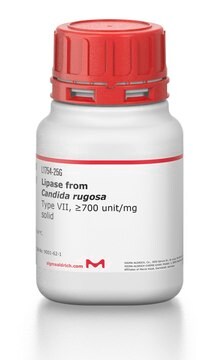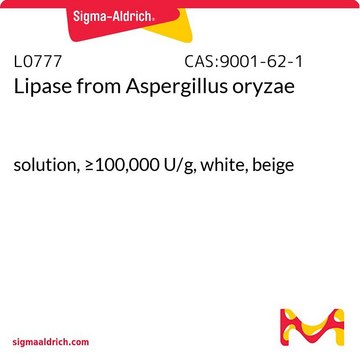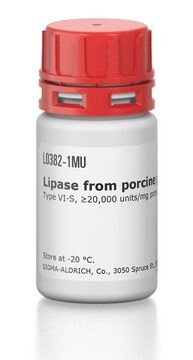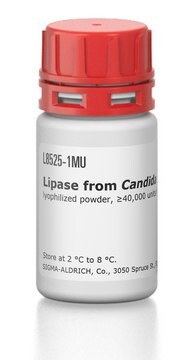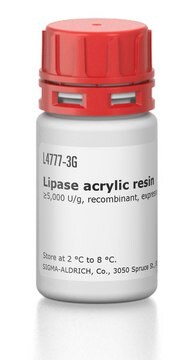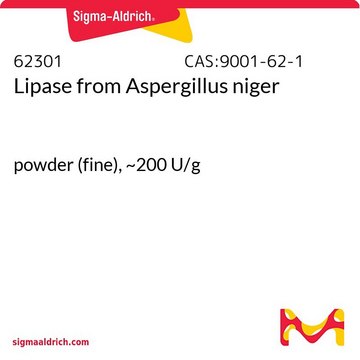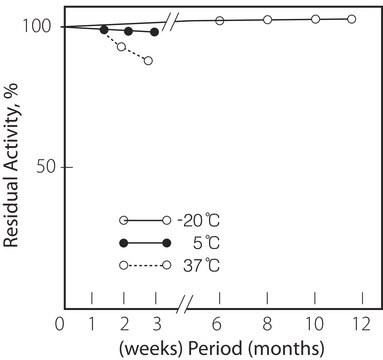L3170
Lipase from Candida sp.
recombinant, expressed in Aspergillus niger
Synonym(s):
Lipozyme CALB L
Sign Into View Organizational & Contract Pricing
All Photos(2)
About This Item
MDL number:
UNSPSC Code:
12352204
NACRES:
NA.54
Recommended Products
recombinant
expressed in Aspergillus niger
Quality Level
form
aqueous solution
enzyme activity
≥5000 LU/g
greener alternative product characteristics
Waste Prevention
Design for Energy Efficiency
Learn more about the Principles of Green Chemistry.
sustainability
Greener Alternative Product
greener alternative category
storage temp.
2-8°C
Looking for similar products? Visit Product Comparison Guide
Related Categories
General description
Lipase from Candida sp or Candida antarctica lipase B (CALB), is a serine hydrolase, which belongs to the α/β hydrolase fold family. It consists of Ser, His, and Asp/Glu catalytic triad and has secondary alcohol binding pocket. Structurally, CALB exists in open and closed conformations and the active site is covered by a small lid. A total of 10 lipases are associated with Candida albicans.
We are committed to bringing you Greener Alternative Products, which adhere to one or more of The 12 Principles of Greener Chemistry. This product has been enhanced for energy efficiency and waste prevention when used in biodiesel research. For more information see the article in biofiles.
Application
Lipase from Candida sp. has been used:
- in Gold nanoparticles (AuNPs) conjugate preparation for biophysical studies
- in lipase activity assay
- for immobilization with Immobead-350
Biochem/physiol Actions
Lipase from Candida sp or Candida antarctica lipase B (CALB) is enantiospecific for secondary alcohols. It has wide industrial applications. Lipases, in general, catalyze triacylglycerol synthesis and breakdown. Lipase B from Candida antarctica (CALB) undergoes interfacial activation and is a popular lipase.
Analysis Note
Minimum 5,000 LU/G of liquid
Storage Class Code
10 - Combustible liquids
WGK
WGK 1
Flash Point(F)
Not applicable
Flash Point(C)
Not applicable
Choose from one of the most recent versions:
Already Own This Product?
Find documentation for the products that you have recently purchased in the Document Library.
Customers Also Viewed
Andre Mong Jie Ng et al.
International journal of molecular sciences, 22(19) (2021-10-14)
Medium-chain triglycerides (MCTs) are an emerging choice to treat neurodegenerative disorders such as Alzheimer's disease. They are triesters of glycerol and three medium-chain fatty acids, such as capric (C8) and caprylic (C10) acids. The availability of C8-C10 methyl esters (C8-C10
Maísa Pessoa Pinheiro et al.
Biotechnology progress, 34(4), 878-889 (2018-03-15)
Novozyme 435, which is a commercial immobilized lipase B from Candida antarctica (CALB), has been proven to be inadequate for the kinetic resolution of rac-indanyl acetate. As it has been previously described that different immobilization protocols may greatly alter lipase
J Hall et al.
The Journal of small animal practice, 54(5), 275-279 (2013-02-13)
Mushroom toxicosis is rarely diagnosed in dogs and is poorly reported in the veterinary literature. This report suggests that mushroom toxicosis is a potentially under-diagnosed condition in first opinion practice in the UK. Nine dogs with clinical signs consistent with
How high-density lipoprotein fuels the failing heart.
Nina Schlueter et al.
Hypertension (Dallas, Tex. : 1979), 61(5), 955-957 (2013-03-06)
Mehran Howaizi et al.
Acta gastro-enterologica Belgica, 75(4), 446-447 (2013-02-14)
Acute pancreatitis has a large number of causes. Major causes are alcohol and gallstones. Toxic causes, mainly represented by medication-induced pancreatitis account for less than 2% of the cases. Cannabis is an anecdotally reported cause of acute pancreatitis. Six cases
Our team of scientists has experience in all areas of research including Life Science, Material Science, Chemical Synthesis, Chromatography, Analytical and many others.
Contact Technical Service